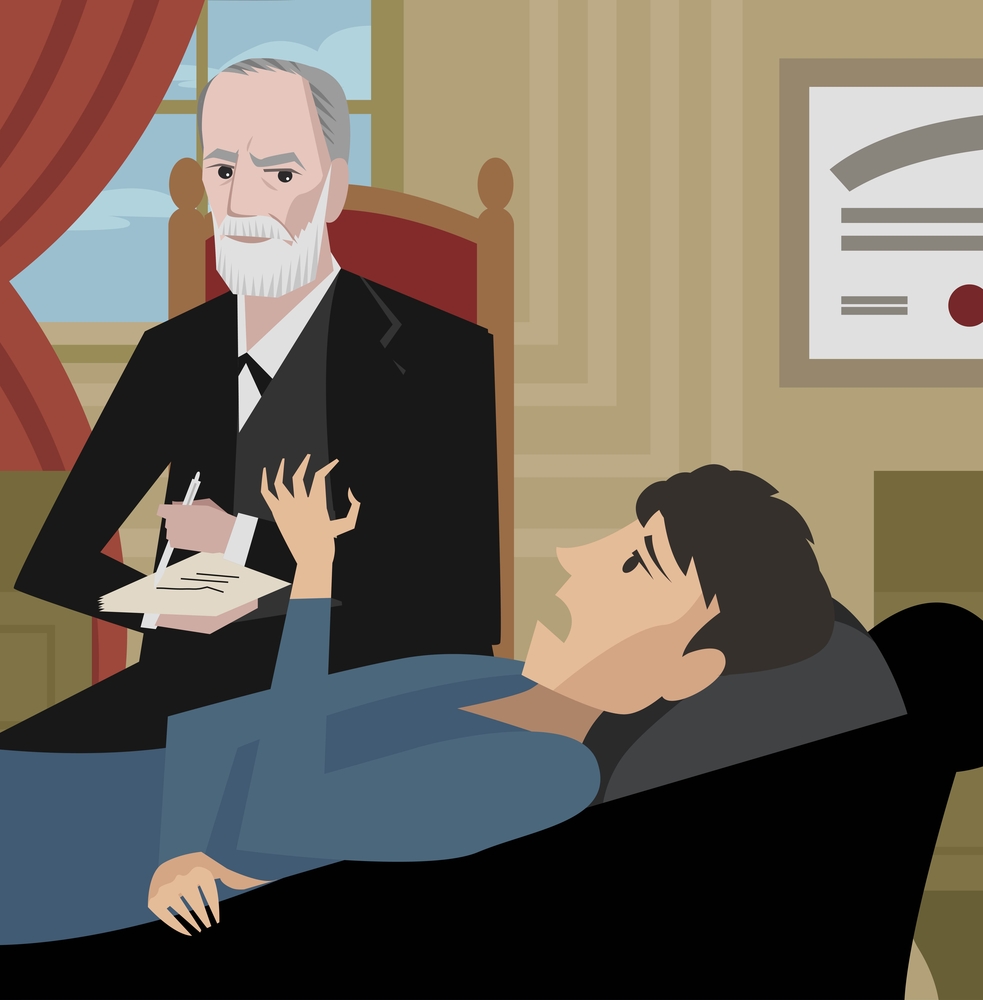Psychodynamic psychotherapy is a therapeutic approach that dives deep into a person’s unconscious thoughts and feelings. It doesn’t just aim to ease symptoms but also foster personal growth and self-understanding. Recent research strongly supports its effectiveness in treating common mental disorders such as depression, anxiety, and personality disorders. As a result, it has received a firm endorsement from the research community, solidifying its role as a critical tool in mental health treatment.
A new study recently published in World Psychiatry reinforces this claim. The researchers, led by Falk Leichsenring, based at the University of Giessen in Germany, report that psychodynamic psychotherapy fulfills the rigorous demands of the most recent criteria for empirically supported treatment (EST) for common mental disorders, such as depressive, anxiety, personality, and somatic disorders.
The authors write:
“The criteria of the new EST model suggest that a “strong” recommendation for PDT in depressive, anxiety, personality, and somatic symptom disorders is most appropriate. This umbrella review suggests that PDT represents evidence‐based psychotherapy for depressive, anxiety, personality, and somatic symptom disorders.”
 Prior research has showcased the effectiveness of psychodynamic psychotherapy as a treatment for various conditions such as mood disorders, anxiety and panic disorders, personality disorders, and post-traumatic stress disorder. The efficacy of this therapy has even been found to rival, or in some instances surpass, that of cognitive-behavioral therapy (CBT). Nevertheless, drawing a concrete conclusion about a treatment’s empirical support requires more than individual studies.
Prior research has showcased the effectiveness of psychodynamic psychotherapy as a treatment for various conditions such as mood disorders, anxiety and panic disorders, personality disorders, and post-traumatic stress disorder. The efficacy of this therapy has even been found to rival, or in some instances surpass, that of cognitive-behavioral therapy (CBT). Nevertheless, drawing a concrete conclusion about a treatment’s empirical support requires more than individual studies.
Original EST criteria dictated that a treatment required just two randomized control trials (RCTs) to demonstrate its superiority to control conditions or its comparable efficacy to established treatments for a disorder. These criteria, however, raised concerns. Critics argued that the focus on symptom reduction overlooked crucial aspects of psychosocial functioning. Furthermore, limited generalizability of study results to real-world clinical practice and potential flaws in study design were pointed out. The authors also underscore significant issues with research outcomes:
“An independent empirical re-evaluation of the studies included in the American Psychological Association’s EST database found replicability and power estimates to be low across almost all ESTs. Some ESTs rated as having ‘strong’ evidence according to the model failed to outperform their ‘modest’ counterparts with regard to efficacy.”
Such concerns prompted the development of a new model for determining empirically supported treatments. This revised approach requires systematic reviews of individual clinical and randomized control trials, evaluations of study quality, clinical and statistical significance, short-term efficacy, and long-term outcomes. It also emphasizes the need to consider factors beyond symptom reduction, the generalizability of results to community settings, the focus on syndromes and complex experiences, and how treatments generate change.
Until now, this new model hadn’t examined psychodynamic psychotherapy rigorously. Hence, the authors’ study aimed to assess the empirical status of psychodynamic psychotherapy through a detailed review of meta-analyses concerning the therapy’s use with adults experiencing common mental disorders. Their team conducted an extensive literature search, examining systematic reviews, meta-analyses, and individual RCTs across databases like PubMed, PsychInfo, and the Cochrane Library. They scrutinized the data using various appraisal and assessment tools, checking for bias risks and assessing the quality of primary studies.
Psychodynamic Treatment and Depression
The study results, categorized by specific conditions, first highlighted the efficacy of psychodynamic psychotherapy for depression. 27 RCTs involving 3,163 participants proved psychodynamic therapy’s superiority to control conditions, medium effect size, and lack of publication bias. Additionally, the team found no difference between the outcomes of psychodynamic therapy and other therapies for depression. They discovered its particular strength in improving patients’ quality of life and its large effect size for treating chronic depression, making it a cost-effective option for patients unresponsive to medication. One RCT suggested African-American men achieved better results with psychodynamic therapy than with pharmacotherapy.
Psychodynamic Psychotherapy for Anxiety Disorders
The team also analyzed research on psychodynamic therapy for anxiety disorders, including panic disorder, agoraphobia, social anxiety disorder, generalized anxiety disorder, and post-traumatic stress disorder. Across studies involving 565 participants in total, psychodynamic psychotherapy showcased a medium effect size for reducing anxiety symptoms. It was found to be as effective as other therapies for panic disorder, social anxiety disorder, and other anxiety disorders.
Psychodynamic Psychotherapy for Personality Disorders
Sixteen RCTs involving around 239 participants examined the effectiveness of psychodynamic psychotherapy for Borderline Personality Disorder and other Cluster C personality disorders. These studies showed the therapy’s medium effect size for reducing core personality disorder symptoms and improving functioning. It also stood equal to other treatments, with no evidence of publication bias detected. One randomized control trial found psychodynamic psychotherapy to be superior to dialectical behavior therapy (DBT) and supportive therapy in the improvement of reflective functioning/
Psychodynamic Psychotherapy for Somatic Symptoms
Seventeen RCTs, including 2106 participants, evaluated psychodynamic psychotherapy for somatic symptom disorders. The therapy demonstrated a moderate effect on somatic symptoms and equal efficacy to other treatments, including CBT. This treatment also had a medium effect size for the improvement of functioning.
Mechanisms of Change
Finally, the researchers studied the mechanisms of change related to psychodynamic psychotherapy’s efficacy. They found that increased insight preceded improvement when working with depressive, anxiety, and personality disorders. Working with transference preceded improvement when working with personality disorders with severe interpersonal problems. Transference was mediated by insight and affect awareness. The therapeutic alliance was also found to be a significant mechanism of change in psychodynamic psychotherapy. Working with association, changes in defense mechanisms were also found to be beneficial when working with anxiety, depression, and personality disorders. Finally, emotional processing was important in the reduction of somatic symptoms.
Given the substantial evidence, the researchers conclude that psychodynamic psychotherapy aligns with the new criteria for EST for depression, anxiety, personality disorders, and somatic disorders. They strongly recommend its usage. Future research will continue to probe this treatment for these and other understudied disorders. As more treatments gain empirically supported status, the mental health field should diversify its arsenal, enabling a broader range of patients to benefit.
****
Leichsenring, F., Abbass, A., Heim, N., Keefe, J. R., Kisely, S., Luyten, P., Rabung, S., & Steinert, C. (2023). The status of psychodynamic psychotherapy as an empirically supported treatment for common mental disorders – an umbrella review based on updated criteria. World Psychiatry, 22(2), 286–304. https://doi.org/10.1002/wps.21104 (Link)















The separation of soma from the brain is ineffective, and I can already discern a fundamental flaw in this research that will inevitably lead to its failure. The body and the brain function as a unified entity, and it is impossible to address the somatic aspects of therapy without considering the influence of the brain, language, and communication. Therefore, right from the start, the categorizations being employed in this research are detached from reality and the holistic nature of the human body.
Furthermore, although this might deviate slightly from the current discussion, I find it relevant to mention that the category of anxiety appears to have relational underpinnings, whereas personality issues seem to be more influenced by societal or group dynamics, and somatic experiences are shared by both. While I understand that a stranger’s opinion on an unfamiliar website may hold little significance, I felt compelled to share my perspective for the benefit of anyone who might be perplexed by these categorizations on an intuitive level.
Report comment
(Sigh.)
Report comment
Doing self-therapy eliminates the bullshit of having to deal with therapists, most of whom in my experience got off on the power and mystery of being a therapist. Having to navigate a therapist’s ego wasn’t worth the effort. And self-healing is possible as long as you know the ins and outs of the healing process.
Report comment
Imo, the most disturbing thing about any professionally “therapeutic” relationship is how (most) therapists use their client’s transference to their own advantage yet are blind to their own; in other words, a client’s transference onto the therapist unconsciously prompts a therapist to to pull rank on the client. And it’s not uncommon for therapists to revel in discomfort this causes their client. This is what makes the power imbalance so damaging in these types of relationships, most of which in essence and practice are a replication of the disrespect and abuse clients already experience in other relationships and is the reason for the success of peer support.
Report comment
Yes, very well said. That was true in my experience, too.
Report comment
Thank you, Mella. The power imbalance is totally bonkers.
Report comment
And the power imbalance exists, due to the undeserved “right” of the scientifically “invalid” psychiatric and psychological industries, to force drug people.
http://psychrights.org/2013/130429NIMHTransformingDiagnosis.htm
Forced and coerced drugging – of all kinds – needs to be made illegal.
Report comment
And I’m pretty certain the Nuremberg codes did make force drugging people up, based upon the ignorance of doctors, illegal … since “The guidelines were based on beneficence and non-maleficence, but also stressed legal doctrine of informed consent.”
https://en.wikipedia.org/wiki/Nuremberg_Code
And now that the psychiatric and psychological industries systemically claim ignorance of the common adverse and withdrawal symptoms of all their psych drugs – which, of course, means they’ve been doing the opposite of giving “informed consent,” for decades, to their patients.
https://www.cambridge.org/core/journals/psychiatric-bulletin/article/brain-shivers-from-chat-room-to-clinic/642FBBAE131EAB792E474F02A4B2CCC0
https://en.wikipedia.org/wiki/Toxidrome
https://en.wikipedia.org/wiki/Neuroleptic-induced_deficit_syndrome
It does strike me that too many of today’s self proclaimed ignorant, non-informed consent giving, psychiatric and psychological doctors – not to mention the mainstream medical doctors who’ve bought into their scientifically “invalid” DSM system – are the Nuremberg criminals of today.
Report comment
Unfortunately, that’s not likely to to happen in any meaningful way for a long time (if ever) as we all know who pulls the strings in that arena. In the meantime, the best (and only) thing to do is avoid the power imbalanced “mental health” system while exposing its lies through the electronic grapevine.
Report comment
This article is so frustrating, and sad. The young researcher author accepts the assumptions and methods — the paradigm — of the study, and its conclusions and recommentations.
As someone who “believed” in the ideas of psychodynamic psychotherapy and tried it off and on for more than 50 years — with very poor to harmful results — I strongly recommend that researchers investigate new methods to study and try to understand the failures of psychodynanic therapy. It might help to build better, and more effective, psychodynamic theories. There are actually a lot of us out here — advertising for participants on this and other sites frequented by those of us hurt by therapy would be a starting point.
I could offer my amendments to the understanding of personality disorders, specifically OCPD and disorders of narcissism, but who in academia or the mental health profession would care or accept what I and others with similar experience have to say? We are people who know PD’s and CPTSD type issues from the inside. What possible information and expertise could there be there?
Report comment
There’s no comparison between academic knowledge and peer support; the first is driven by egoism while the latter other is born of fellowship. And no one really knows life until they’ve lived it.
Report comment
Omgoodness Birdsong- I could not have said it better. It is reading stories and comments by people with lived experience that brings healing and comfort to me personally. I am grateful for the ones trying to do little bits to make it softer for those fellow travelers. Thank you.
Report comment
I feel the same way, AnnieOakley. Confiding in people out to make a buck (“psychotherapy”) isn’t worth a damn imo.
Report comment
There’s no better therapy than hearing from someone who’s been there and isn’t charging you for it.
Report comment
The therapist often role plays as an omniscient human who will guide us to correct our defects, ease our past trauma and lift our despair– a combination oracle and mind reader. No human has those powers, though many of us so desperate for relief we collude in the therapist’s mythology. Their writings give this unspoken promise as well, with the admonition, “you have to want to change.”
I think (for some of the) trouble starts when the therapist doesn’t recognize what she does to assert dominance. She pays lip service to the “power differential.” not realizing when she portrays herself as ultimate “Truth Teller,” contradicting clients, diagnosing, feigning omniscience, etc., she’s asserting dominance, no matter how kindly, cooing and fake empathetic she is.
Therapists don’t explain how a subordinating, regressive relationship creates agency and autonomy or how its contrived, asymmetrical bonding somehow make a road toward authenticity.
Please, therapy inevitably is a relationship between two people, bringing in all our human responses and social conditioning. Nothing magical happens.
A client blog discusses the fallacies:
https://disequilibrium1.wordpress.com/
Also here’s a thoughtful closed forum for clients. (Please, respect clients. No providers“defending” the modality.)
https://therapytheclientside.invisionzone.com/
Report comment
I will only take this moment to state that not ALL therapists see their role as to identify and/or correct defects in their clients. I think you are acknowledging that in your choice of words, but I want to make that explicit. My view has always been that the only ones who can tell us if therapy “works” are the ones receiving the therapy. They’re also the only ones knowing if something is “wrong” with them and/or what if anything they need to do about it. A good therapist works to help the client discover their own truths about themselves. Anyone who thinks they can “fix” or “improve” the client should be avoided like the plague!
Report comment
Wow, Steve. How often therapists have to be the Voice of Authority. In the passion of your defense, I fear you missed my message–that therapists often are unaware of the diminishing they dynamic created by their dominance signaling, no matter how many “good for yous” they intone.
Can we lighten up? It’s just a comments section. This isn’t a thesis defense or a scientific journal demanding precise reporting, with citations. For the record, I deliberately did couch my comment with conditional words. But in my personal experience and in these discussions I see the practitioner need to be “be smarter than the client” widespread in the therapy field.
Thanks for saying that therapists can’t “fix” or “improve” a client. I saw a few of those.
Report comment
I didn’t meant to be critical, just to make that very point. I’d say the odds of finding what I call a “good therapist” these days are probably in the single digits.
Report comment
Steve, I’ve no idea how many therapists I’d consider good. I just know I suffered some bad ones, and ones I knew socially were in the top 10 percent of hubristic. I was attempting to make a point about the inevitability of dominance signaling in therapy, which was my take-away, no matter how much my therapists worked their cooing and engineered the sympathy. My therapists needed to be the smartest person in the room. I also found them so down their theoretical rabbit holes, they were blissfully unaware that here sat two people in a room that’s not mystical or magical no matter how contrived.
Report comment
I am not surprised to hear any of that. The system is set up so that narcissism is rewarded. Back when I got my own therapy (1982), there were requirements that therapists go through their own therapy before being allowed into the office, and there was strong recognition that the therapist could do a lot of damage if s/he had not dealt with his/her own issues and instead acted them out on the client. Nowadays, I’m not sure they even train counselors on the fact of unconscious motivations they might have. I’d say one takes one’s life in his/her hands applying to a random “therapist” for help today. Odds are better that you’ll get screwed over than helped. I think that was already true in 1982, but it’s far worse today.
Report comment
The therapy profession is based dominance signaling: power imbalance, invented diagnoses, charging $$$.
Report comment
disequilibrium1,
Your essay was one of the first thing I found when I began searching the internet for something to corroborate my disgust and frustration with the mythology of “psychotherapy”. Your well-chosen words helped me know I was on the right track.
Most therapists don’t tell clients how to gain agency and autonomy because if they did they’d lose clients, just like the wizard in the Land of Oz.
Report comment
Birdsong, thanks so much for your words. Wizard of Oz is just how I experienced it. I found my therapists who had no idea how to help me gain agency and autonomy, and seemed quite invested in keeping my awestruck and deferential.
After a 10-year discussion my essay spun off into a forum one of the discussants began.
https://therapytheclientside.invisionzone.com/
Your comments here were noted, enthusiastically.
Report comment
disequilibrium1,
I can’t thank YOU enough for taking the time to write and post what you did in 2010. Your spoke for me. And I’m delighted it spun off a forum 🙂
Dorothy got help from her flawed companions, the Tin Man, Scarecrow, Cowardly Lion, or even Glinda the Good Witch—not the “Wizard”.
Report comment
To me the Wizard of Oz is a metaphor for life. Dorothy’s longing for home represents the search for the Self. And The Ruby Slippers symbolize the belief in oneself, which Dorothy lost when no one at home listened to her.
Everyone is born wearing The Ruby Slippers. But psychiatry thinks everyone’s Ruby Slippers are full of holes, (as would Miss Almira Gulch).
Report comment
Isn’t psychodynamic psychotherapy already thing of the past? I am not going to ever pay for this. Working with the unconscious. Your next article should be about Reiki healing and palm reading.
Report comment
Um, no, it sure isn’t and it is the one that hurt me the most. Maybe it was the practitioner skill set, maybe because it was the wrong type of therapy for me -I don’t know.
My therapist said that she was a Interpersonal Therapist, but frustration caused me to try to figure out what was going on. Psychodynamic supportive therapy was the best I could come up with as to what went on in our sessions. A big, fat nothing burger- felt very invalidating much of the time.
She kept her clients coming to her for years and years and ran process group therapy sessions where it was common for members to stay 25 plus years.
She did not dialogue. There was no compassionate inquiry; no psycho-education; no skills taught; and no requests for feedback.
She was kindly and nice. A bump on a log, but a fluffy bump, who from time to time trickled out a teaspoon of something insightful (interpretation ?), but not very often. There was no Socratic questioning and maybe going somewhere thoughtful and deeper. No just two humans talking.
From the sounds of this article, it would seem that the “Industry” is trying to prove Psychodynamic Therapy to be “scientifically” significant, legitimizing it as a therapeutic option to help the “disorders” listed, so that all the licenses and money spent on schooling or years practicing the modality will not be in vain.
Very much how bureaucratic agencies pick the lowest hanging fruit and then spend their time and energy on justifying their existence and the money spent.
Perhaps this is a tad too cynical, but it is the vibe I am getting. My thinking goes in this direction because there is a significant flaw in the study ( a red flag for me) -the self-reporting of the participants. I read the study and do not see where they accounted for this bias, leading me to think that the researchers biases had not really been addressed in the formulation of the study.
Anyone who has been in therapy knows how vulnerable one feels. How one is desperate for help. And how one tends to override the red-flag discomforts and gut instincts, and many times, protects the therapist’s feelings by not disclosing that they are not helping. After all, the therapist wields far too much power over the client and the client is very aware of this “expert” / “patient”dynamic.
Send three different interviewers (blinded) to ask these participants about their perspectives, providing therapy with the trial therapist has ended, let’s say, about three to four years out, after they have had time to reflect on their experience.
I’m betting the results will be vastly different.
Report comment
That’s the vibe I’m getting from this article. It’s public relations disguised as research, the tried and true way of attempting to control a narrative quickly being lost (thank goodness) to an amazing thing called the internet.
Report comment
Correction: It’s research disguised as public relations.
Report comment
You should be very careful when you talk about therapy. It’s not the solution to all the problems. I personally had a awful traumatic experience in therapy who left me shattered and suic***l. So please I’m not saying don’t go to therapy but be really careful to whom you confide your most inner secrets. My therapist flirted with me and sexually harassed me (13 years older than me). She literally started to mast***te in front of me in an attempt to turn me on and have s*x. It was fuck**g disturbing and I’m still recovering from it. Research says most of people who have been harmed by therapy never recover, and I think I, myself, never will recover. So don’t push therapy so much cause it’s not that great honestly.
Have a nice day.
Report comment